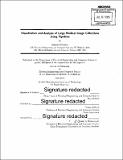Visualization and analysis of large medical image collections using pipelines
Author(s)
Sridharan, Ramesh
DownloadFull printable version (14.72Mb)
Alternative title
Visualization and analysis of computational pipelines for large medical image collections
Other Contributors
Massachusetts Institute of Technology. Department of Electrical Engineering and Computer Science.
Advisor
Polina Golland.
Terms of use
Metadata
Show full item recordAbstract
Medical image analysis often requires developing elaborate algorithms that are implemented as computational pipelines. A growing number of large medical imaging studies necessitate development of robust and flexible pipelines. In this thesis, we present contributions of two kinds: (1) an open source framework for building pipelines to analyze large scale medical imaging data that addresses these challenges, and (2) two case studies of large scale analyses of medical image collections using our tool. Our medical image analysis pipeline construction tool, PipeBuilder, is designed for constructing pipelines to analyze complex data where iterative refinement and development are necessary. We provide a lightweight scripting framework that enables the use of existing and novel algorithms in pipelines. We also provide a set of tools to visualize the pipeline's structure, data processing status, and intermediate and final outputs. These visualizations enable interactive analysis and quality control, facilitating computation on large collections of heterogeneous images. We employ PipeBuilder first to analyze white matter hyperintensity in stroke patients. Our study of this cerebrovascular pathology consists of three main components: accurate registration to enable data fusion and population analysis, segmentation to automatically delineate pathology from the images, and statistical analysis to extract clinical insight using the images and the derived measures. Our analysis explores the relationship between the spatial distribution, quantity, and growth of white matter hyperintensity. Our next application of PipeBuilder is to a neuroimaging study of Alzheimer's patients, where we explicitly characterize changes over time using longitudinal data. As with the previous application, we introduce a workflow that involves registration, segmentation, and statistical analysis. Our registration pipeline aligns the large, heterogeneous group of populations while still accurately characterizing small changes in each patient over time. The statistical analysis exploits this alignment to explore the change in white matter hyperintensity over time.
Description
Thesis: Ph. D., Massachusetts Institute of Technology, Department of Electrical Engineering and Computer Science, 2015. Title as it appears in MIT Commencement Exercises program, June 5, 2015: Visualization and analysis of computational pipelines for large medical image collections. Cataloged from PDF version of thesis. Includes bibliographical references (pages 80-100).
Date issued
2015Department
Massachusetts Institute of Technology. Department of Electrical Engineering and Computer SciencePublisher
Massachusetts Institute of Technology
Keywords
Electrical Engineering and Computer Science.